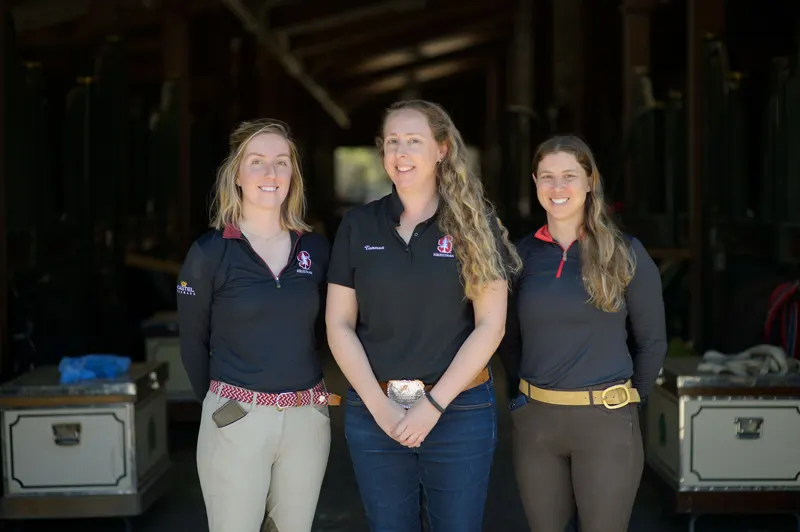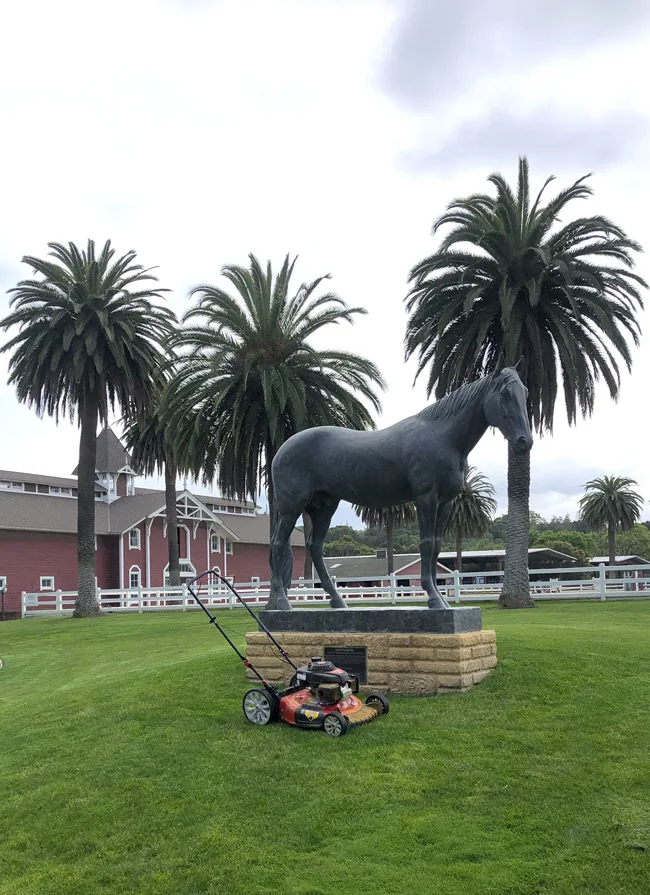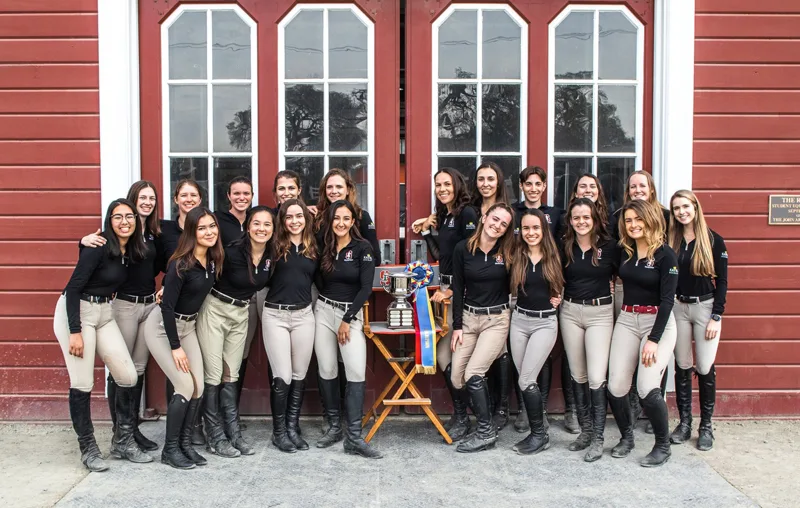I have been at the Stanford Red Barn in Stanford, California, first as a student and now as a coach, for almost half of my life, and I don’t think anything could have prepared me for the challenges of the past three months. I sat in my office that Friday in March (Friday the 13th, in fact), reading the reports of closures from Stanford, saying teary and hasty goodbyes to students, and trying to make a plan unlike any other I have been asked to put into place.
As the world started to shut its doors and engage in the most ambitious public health emergency measures of our lifetime, we had 48 hours to figure out how to keep 103 living animals cared for with no students, no owners, nonnegotiable personal health measures, and the smallest fraction of essential personnel manageable.
Because one of the students I sent off was unknowingly COVID-19 exposed, I spent the first 14 days enacting this plan while in quarantine about five miles from the farm. To say that I am proud of my staff and their efforts would be such a gross understatement. The very day that nonessential staff members were told to go home—many of whom have still not returned—my two assistant coaches, Tina Davey and Katie Steiner, started their 13-week vigil, each trading half-day shifts in the barns, working to provide care and some exercise for Stanford’s 33 horses.

(From left) Stanford coaches Katie Steiner, Vanessa Bartsch and Tina Davey worked tirelessly to provide care and exercise to Stanford’s 33 equestrian team horses during the COVID-19 shutdown in California. Hope Hudson Photo
While there is no way to ride and handle each of 15 horses in five hours—something we usually have 40 athletes to do—we began to reach out to a small group of local current and former student-athletes who volunteered to come in for a half-day along with our assistant coaches. And in this way, two at a time in the barn, we meticulously washed, bleached, gloved and masked our way through the weeks on end.
During this time, we also cared for an additional 75 horses boarded at the Red Barn by faculty, staff, alumni and community, as no owners were allowed. Our barn manager and groomsmen did yeoman’s duty alongside the two professionals from each of the training programs allowed in to care for the privately owned horses.
Our groomsmen start their shift at 4:30 a.m., loading up 500 pounds of hay and traversing the six barns, tossing feed to the hungry horses. As they begin cleaning the stalls (an activity that happens three times a day), they put their eyes on each animal to make sure they appear healthy, are eating, and have no signs of distress. So, while they spend much of the day pushing heavy wheelbarrows and loading endless buckets of manure, they are each incredibly experienced horsemen in their own right and often the person who catches an ill or injured horse before there is a catastrophic issue.
ADVERTISEMENT
They did this bravely and tirelessly from Day 1. One of our grooms started working at the Red Barn in 1970 and moved his planned retirement by a month to make sure we were covered, unwilling to hang up his boots until last week when we moved into Phase 2.

Raphael Rodriguez postponed his retirement when COVID-19 hit to help care for the horses at Stanford’s Red Barn. Vanessa Bartsch Photo
The first day I was cleared by my doctor and returned to the Red Barn, it was an eerie sight. Unlike the bustling barns full of physical education classes, equestrian team practices and friendly professors coming to ride after class, there was a quiet unlike anything I can remember across the property. There were no cars on Campus Drive. With the golf course only allowed a skeleton crew of their own, there was no hum of mowers and friendly waves from their staff. Trips across campus to gather mail and more personal protective equipment were like something out of a movie with an utterly empty quad as the bell tower struck noon, unkempt landscapes, and the feeling that a hive of activity had suddenly been emptied.
But, my staff was there in full swing. I quickly learned you can see when someone is smiling, even while wearing a mask. It took longer to learn about which masks work for which faces, situations and settings, but I am now an expert at that, as well as reading county and state orders, emailing questions to our lawyers, and reviewing handwashing protocols in several languages.
I am also an expert lawn mower. With all landscape services paused, I decided there was no need for a Peloton with acres of unmowed lawn, so I purchased the cheapest gas push mower from Home Depot and began volunteering my time at the end of each on-campus shift while I was already decked out in my mask and gloves. I have logged over 21 miles of walking/mowing. My staff loves giving me tips. The first tip was that I should have thought about buying a self-propelled mower.

Vanessa Bartsch’s lawnmower at rest in front of the statue of Leland Stanford’s celebrated stallion Electioneer at the entrance to the Stanford Red Barn. Vanessa Bartsch Photo
As portions of the shelter-in-place order have been lifted, we have returned to some more normal activities—still with a vastly limited crew, classes on hygiene, daily health checks, and a quest to find PPE available for purchase online that has become a borderline obsession for me. We rejoiced in our ability to give private lessons again. We have been grateful to have the entire Stanford Athletics family helping to navigate our on-campus challenges, especially during the early days (you try finding Clorox wipes Week 2 of a pandemic!), and we are now happy to be a resource to other parts of campus regarding safe ways to operate during this new normal.
Throughout this ordeal, I have had a lot of sleepless nights worrying about keeping my staff safe and worrying about an unknown future, as all of our focus inevitably shifts from micro to macro and back again.
ADVERTISEMENT
I have also had a lot of time behind that mower to reflect on why it is that Stanford, and the Athletic Department, still have a Red Barn at all. While it is in part because we are an athletic hub: There are over 450 collegiate equestrian teams in the country, some an emerging NCAA sport, some varsity, some club, and ours has finished third at the IHSA National Finals the last three years in a row. But it is much more than that. Leland Stanford bought the Palo Alto Stock Farm to breed and raise racing horses for the predominant sport of the times. He pushed the envelope and revered the notions of athletic excellence that we so embrace.

Stanford University’s equestrian team has finished in the top three at the Intercollegiate Horse Shows Association National Championships for the past three years. Photo Courtesy Of Stanford Equestrian Team
But the Red Barn is also a learning laboratory where P.E. classes, plein air painting classes, film studies and the pre-vet club can meet. We offer boarding in part because we are self-sustaining like the golf course and Stanford Campus Recreation Association. Our budget doesn’t include funds from the Department of Athletics Physical Education and Recreation or the university for our operation. The head of the human biology department, an amazing volunteer who still comes in twice a week to run the hot walker and feed the horses their medications, can sit on the fence (from 6 feet away!) and talk to pre-med students about their plans, worries and successes.
It is also a place where students of every race and background have a chance to take part in a sport that tends to be rooted in either the most rural or most privileged settings.
Most of the Red Barn was built in the late 1870s, and in its 145-plus year history, it has survived more than we can imagine: earthquakes, two world wars (the cavalry used to practice at the Red Barn), protests, civil uprisings and more than one pandemic. As I drive to my job each day and see the cupola of the barn rising over the trees, it is a reminder to me that Stanford has survived seemingly insurmountable challenges in its long history and that I—and we—will work together to not just survive this too, but emerge stronger, more conscious of those around us and the challenges they face and more appreciative of our ability to affect the history of our era.
Vanessa Bartsch is the head coach of the Stanford Equestrian Team and a member of the Intercollegiate Horse Shows Association board of directors. Bartsch and her team were honored with the Leading with Courage Award from the Stanford Athletic Department due to their work throughout the COVID-19 shutdown.














